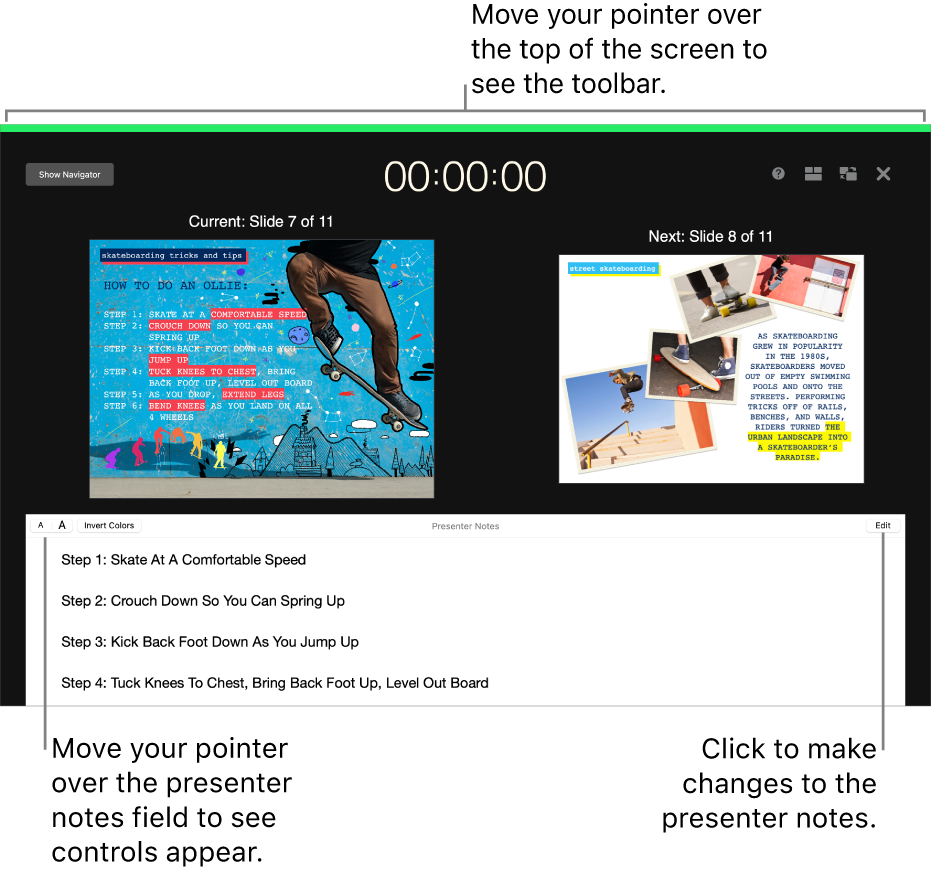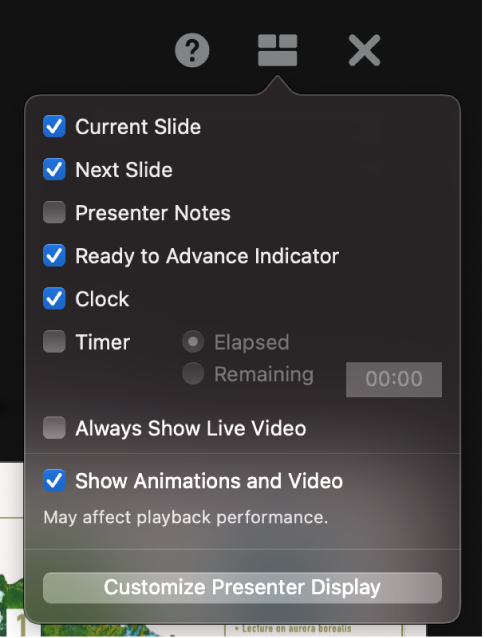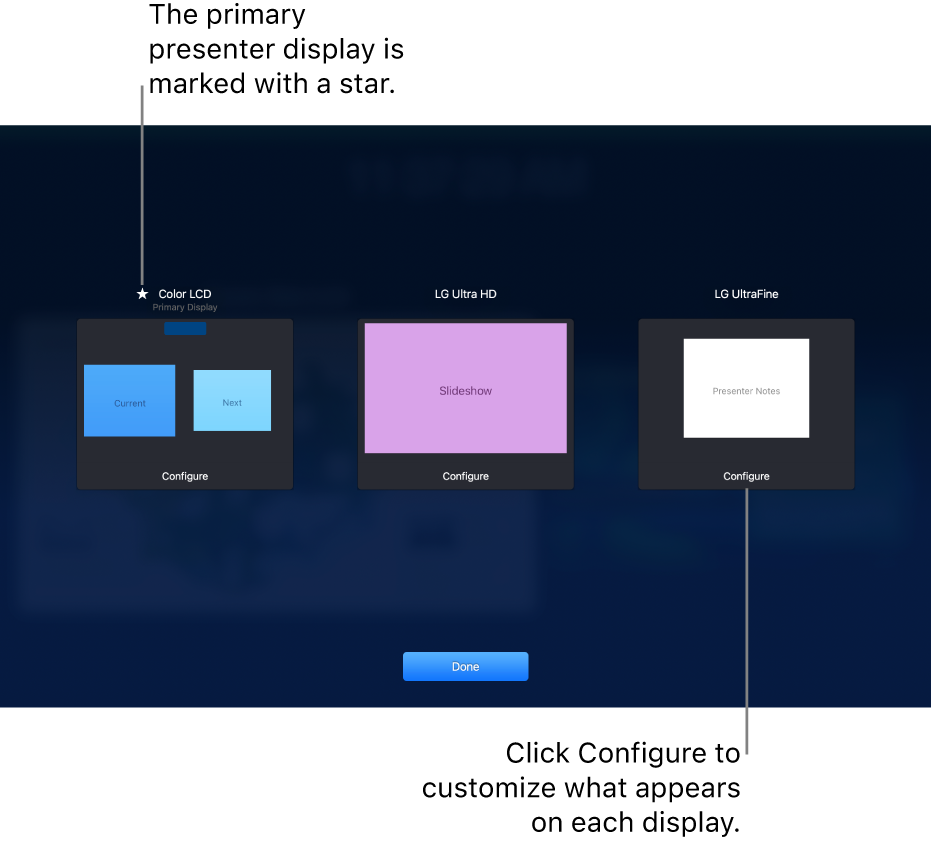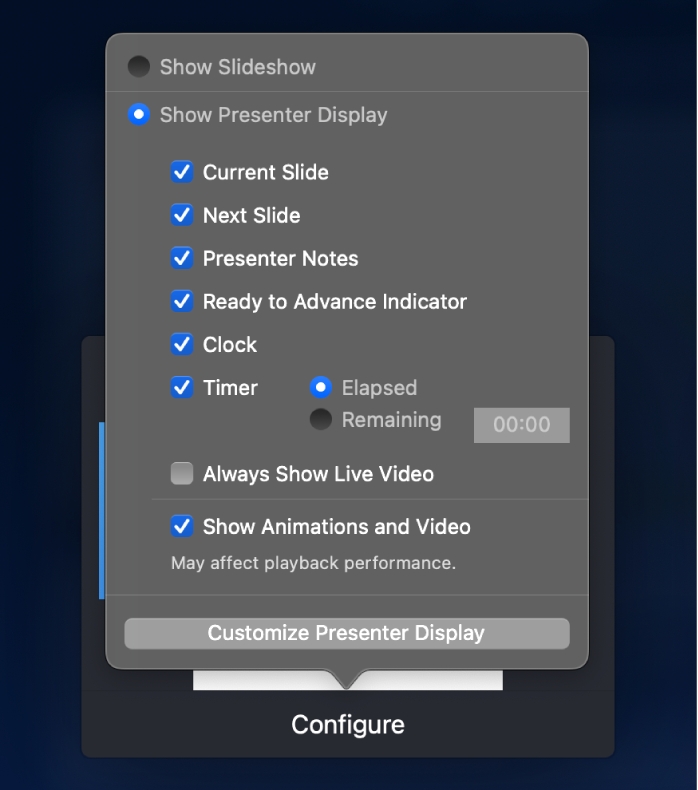
Play a presentation on a separate display in Keynote on Mac
You can connect one or more separate displays to your Mac and play your presentation on one of the connected displays, while you control the presentation using the presenter display on your Mac. You can set the presenter display to show any combination of slides, presenter notes, a clock, and a timer to aid in your presentation. You can also choose which display the slideshow plays on.

Present with one or more external displays
Go to the Keynote app
 on your Mac.
on your Mac.Connect one or more external displays to your computer.
Check the documentation that came with your displays to determine what cable or adapters you may need.
To prevent viewers from seeing the presenter display on the connected displays, turn mirroring off. Do one of the following:
On a Mac: Choose Apple menu

On a Windows computer: Right-click the desktop, choose Screen Resolution, click the Multiple Displays menu, then choose “Extend desktop to this display.”
In Keynote, open the presentation you want to play, then click the slide in the slide navigator you want to play first.
Choose Play > In Fullscreen (from the Play menu at the top of your screen), then click
 in the toolbar.
in the toolbar.By default, the slideshow appears on one of the external displays, and the presenter display appears on your Mac and any other connected displays.
Tip: To quickly change which display the slideshow and presenter display appear on, press X on the keyboard until they appear on the screens you want.
To reveal the toolbar to show the slide navigator, keyboard shortcuts, live video sources, or multipresenter slideshow controls, move the pointer anywhere on the presenter display, then click a button at the top of the screen.

To start the presentation, press the Space bar or Right Arrow key.
The timer at the top of the presenter display starts, and a red or green bar at the top of the presenter display indicates the status of the slideshow. A red bar indicates a transition or animation is playing; the bar turns green when it is done.
Note: In a side-by-side layout, when the next slide doesn’t immediately appear, it means a slide transition or build is still playing on the current slide. The next slide appears only when the presentation is ready to advance.
Do any of the following:
Go to the next slide or build: Press the Space bar or Right Arrow key.
Go to the previous slide or reset the previous build: Press the Left Arrow key.
Jump to a different slide: Click Show Navigator in the top-left corner of the presenter display, then click a slide in the slide navigator.
Jump to a specific slide number: Press any number key, then press Return.
To exit the presenter display and stop playing the presentation, press Esc.
Customize the presenter display with one connected display
While you’re presenting a presentation on a separate display, you can select which items appear on the presenter display and modify its layout.
Go to the Keynote app
 on your Mac.
on your Mac.Play a presentation in full-screen mode.
Move the pointer over the presenter display, click
 in the top-right corner of the screen, then select or deselect the checkbox next to an item to show or hide it.
in the top-right corner of the screen, then select or deselect the checkbox next to an item to show or hide it.
To change the layout of items on the presenter display, click the Customize Presenter Display button at the bottom of the dialog, then do any of the following:
Move an item on the presenter display: Drag it.
When you drag a slide, its label always moves with it. To position a label independently of the slide, drag only the label. To drag multiple items simultaneously, Command-click or Shift-click to select them, then drag the items.
Resize an item on the presenter display: Click the item, then drag any selection handle.
The clock, timer, and labels are always resized proportionally from their centers.
To maintain the proportions as you resize a slide, the Presenter Notes field, or the Ready to Advance Indicator, press and hold Shift as you drag. To resize from the center, press and hold Option as you drag. To proportionally resize from the center, press and hold Shift and Option as you drag.
Automatically position the items on the presenter display: Click the Use Auto Layout button. Keynote positions the items to make optimal use of the presenter display.
Change the appearance of presenter notes: With presenter notes showing, move the pointer over the Presenter Notes field, then click a font button in the top-left corner to make the font smaller or larger. Click the Invert Colors button to show white text on a black background or vice versa (other text colors aren’t affected).
Press Esc on your keyboard to return to the presentation.
You can use rehearse slideshow mode to customize the presenter display and practice your presentation without connecting an external display. See Rehearse a Keynote presentation to learn more.
Customize the presenter display with two or more connected displays
If you have two or more external displays connected to your Mac, you can change what appears on each display.
Go to the Keynote app
 on your Mac.
on your Mac.Play a presentation in full-screen mode.
Move the pointer over the primary presenter display, then click
 at the top of the screen.
at the top of the screen.
Thumbnail images of up to six connected displays are shown. The primary presenter display has the label Primary Display with a star next to its name.
Click Configure at the bottom of a thumbnail, then do any of the following:

Show the current slide: Click Show Slideshow.
Show the presenter display: Click Show Presenter Display.
Change the items that show on a presenter display: Click Show Presenter Display, then choose any combination of options from the list. For example, you can set your presenter notes to show on the primary display, and set the current and next slides to show on a separate display.
Change the layout of items on a presenter display: Click Show Presenter Display, click Customize Presenter Display, then make changes. To learn more, see “Customize the presenter display with one connected display,” above.
Click Done.
Tip: You can stop notifications from appearing on your screen while you present. On your Mac, choose Apple menu 